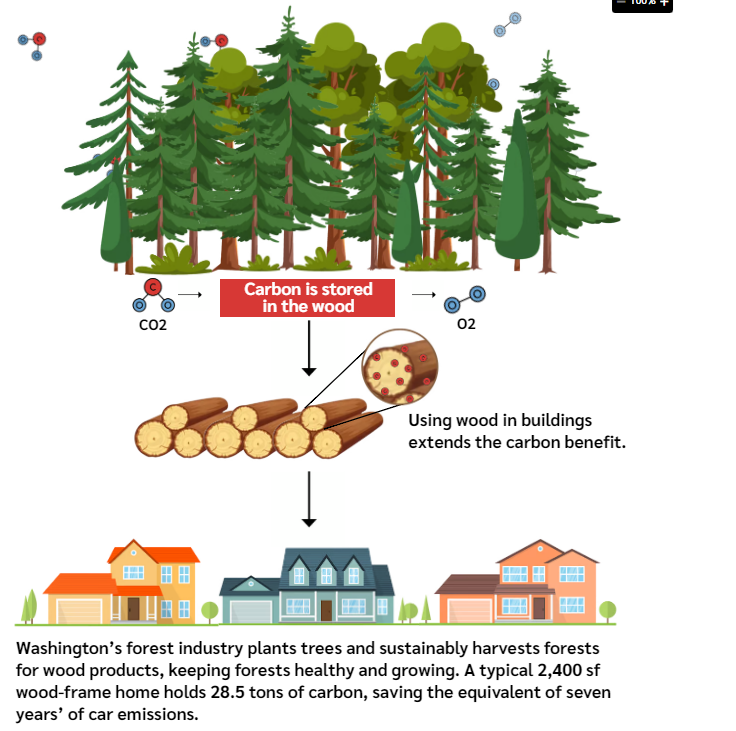WASHINGTON FOREST PROTECTION ASSOCIATION
Carbon Sequestration
About the Forest Products Sector Carbon Bill
The Forest Products Sector Carbon Bill, also known as HB 2528, is significant legislation recognizing the crucial role of the forest products sector in combating climate change. Enacted on March 25th, 2020, this law highlights that private forestry can annually sequester 12% of the state’s carbon emissions.
Well-managed forests supply renewable timber, keeping carbon stored within wood products over their lifespan.
The bill emphasizes that a thriving forest products sector is essential for the ongoing process of capturing and sequestering carbon in growing trees. Research from the University of Washington underscores the contribution of private working forests in mitigating global warming, showing that wood products and net forest growth collectively accounted for approximately 12% of the effort in 2015.
Myths
- The forestry and wood products industry do not contribute to reducing our state's carbon footprint.
- Once a tree is harvested, the stored carbon is lost and returns to the atmosphere.
- Commercial tree cutting is unsustainable.
- Leaving forests untouched benefits the environment.
- Most harvested trees are burned or decomposed, releasing carbon back into the atmosphere.
Facts
- Growing trees absorb carbon dioxide and store it in wood products. Sustainable forestry plants 52 million carbon-absorbing trees annually.
- Carbon remains stored in wood products throughout their life, reducing atmospheric carbon when used for construction, furniture, and more.
- Trees planted today are intended for harvest 30–60 years from now, with three trees planted for every one harvested, ensuring a sustainable cycle.
- Unhealthy forest conditions lead to catastrophic wildfires; forestry helps maintain healthy forests by removing dead trees and reducing wildfire severity.
- Harvested trees are used for lumber, landscaping bark, plywood, paper, and renewable electricity, actively removing carbon from the atmosphere..
Frequently Asked Questions
Scientists, researchers, environmental organizations, and working foresters recognize trees as a natural climate change solution, with sustainably managed forests effectively sequestering greenhouse gases. A group of 48 CEOs from forestry, conservation, and environmental organizations, including the Nature Conservancy and the Environmental Defense Fund, has endorsed principles acknowledging the role of sustainable forests and forest products in mitigating climate change.
Foresters collaborate with state agencies, biologists, and communities to safeguard wildlife. Sustainably managed forests offer valuable fish and wildlife habitat, recreational opportunities, water quality protection, and other natural resource benefits. In Washington, private forestland owners have restored over 6,500 miles of fish waterways by removing or replacing 9,200 stream blockages and in 2021 have completed the upgrade of roads and elimination of fish barriers on private lands.
Growing, harvesting and thinning are essential for managing forests, and enhancing their resilience to wildfires, diseases, and infestations. Sustainably managed forests provide wildlife habitat, and recreational spaces, and contribute to air and water quality maintenance.
Virtually every part of a harvested tree is used to make lumber, cross-laminated timber, and various durable wood products. Additionally, wood shavings, branches, and other tree residuals are utilized to create paper, medicine, food ingredients, cosmetics, renewable fuel, and other everyday products.
Washington State aims to reduce 95% of its carbon emissions by 2050, necessitating a multifaceted approach. Trees, being a natural carbon sink, play a crucial role in removing greenhouse gases from the atmosphere. A robust forestry industry ensures a continuous cycle of planting, harvesting, and replanting to maintain this carbon cycle.
Concrete and steel production relies on energy-intensive processes primarily powered by fossil fuels. In contrast, wood-based building materials have a considerably lower carbon footprint and generate fewer carbon emissions. Wood is also a renewable resource, growing naturally.
The building sector emits nearly 40% of the world's carbon. We can lower our carbon footprint by using wood.
MANAGED FORESTS AND WOOD PRODUCTS LOWERS OUR CARBON FOOTPRINT
The facts: As trees grow, they absorb carbon dioxide from the air, and store carbon in the wood of the tree. Cabon is not released unless trees or wood decay or burn. Using wood in building products stores carbon in the built environment for decades.
The facts: As trees grow, they absorb carbon dioxide from the air, and store carbon in the wood of the tree. Cabon is not released unless trees or wood decay or burn. Using wood in building products stores carbon in the built environment for decades.
The forest industry is part of a carbon-friendly solution.
Managed forests and wood products are a naturally occurring part of the solution to address goals for reducing carbon emissions by storing carbon in the forest and wood products. Scientific research has demonstrated that forests provide environmental values, including removing carbon dioxide from the atmosphere that non-forested landscapes cannot.


